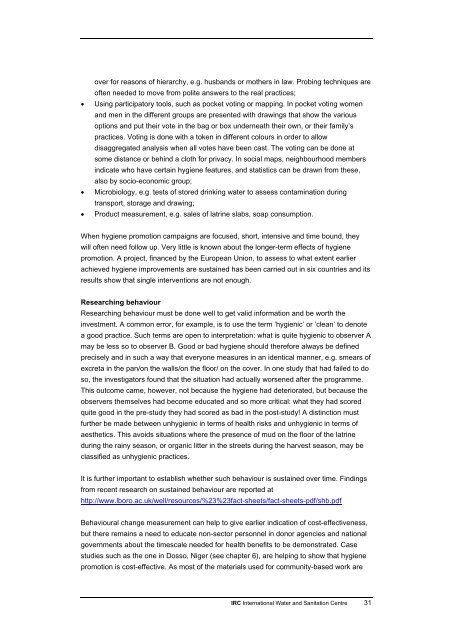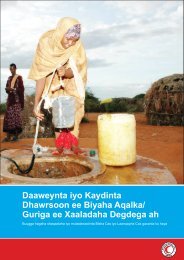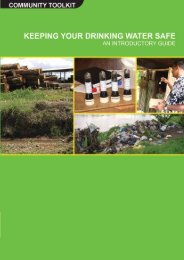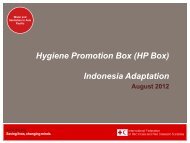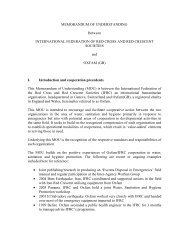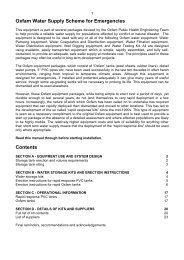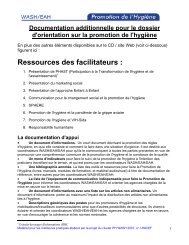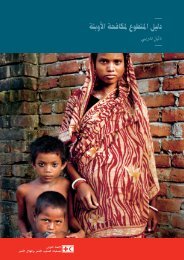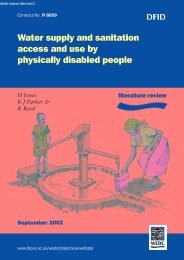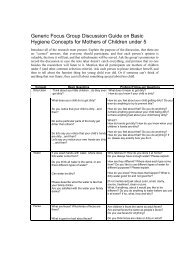Hygiene Promotion - IRC International Water and Sanitation Centre
Hygiene Promotion - IRC International Water and Sanitation Centre
Hygiene Promotion - IRC International Water and Sanitation Centre
Create successful ePaper yourself
Turn your PDF publications into a flip-book with our unique Google optimized e-Paper software.
over for reasons of hierarchy, e.g. husb<strong>and</strong>s or mothers in law. Probing techniques areoften needed to move from polite answers to the real practices;• Using participatory tools, such as pocket voting or mapping. In pocket voting women<strong>and</strong> men in the different groups are presented with drawings that show the variousoptions <strong>and</strong> put their vote in the bag or box underneath their own, or their family’spractices. Voting is done with a token in different colours in order to allowdisaggregated analysis when all votes have been cast. The voting can be done atsome distance or behind a cloth for privacy. In social maps, neighbourhood membersindicate who have certain hygiene features, <strong>and</strong> statistics can be drawn from these,also by socio-economic group;• Microbiology, e.g. tests of stored drinking water to assess contamination duringtransport, storage <strong>and</strong> drawing;• Product measurement, e.g. sales of latrine slabs, soap consumption.When hygiene promotion campaigns are focused, short, intensive <strong>and</strong> time bound, theywill often need follow up. Very little is known about the longer-term effects of hygienepromotion. A project, financed by the European Union, to assess to what extent earlierachieved hygiene improvements are sustained has been carried out in six countries <strong>and</strong> itsresults show that single interventions are not enough.Researching behaviourResearching behaviour must be done well to get valid information <strong>and</strong> be worth theinvestment. A common error, for example, is to use the term ‘hygienic’ or ‘clean’ to denotea good practice. Such terms are open to interpretation: what is quite hygienic to observer Amay be less so to observer B. Good or bad hygiene should therefore always be definedprecisely <strong>and</strong> in such a way that everyone measures in an identical manner, e.g. smears ofexcreta in the pan/on the walls/on the floor/ on the cover. In one study that had failed to doso, the investigators found that the situation had actually worsened after the programme.This outcome came, however, not because the hygiene had deteriorated, but because theobservers themselves had become educated <strong>and</strong> so more critical: what they had scoredquite good in the pre-study they had scored as bad in the post-study! A distinction mustfurther be made between unhygienic in terms of health risks <strong>and</strong> unhygienic in terms ofaesthetics. This avoids situations where the presence of mud on the floor of the latrineduring the rainy season, or organic litter in the streets during the harvest season, may beclassified as unhygienic practices.It is further important to establish whether such behaviour is sustained over time. Findingsfrom recent research on sustained behaviour are reported athttp://www.lboro.ac.uk/well/resources/%23%23fact-sheets/fact-sheets-pdf/shb.pdfBehavioural change measurement can help to give earlier indication of cost-effectiveness,but there remains a need to educate non-sector personnel in donor agencies <strong>and</strong> nationalgovernments about the timescale needed for health benefits to be demonstrated. Casestudies such as the one in Dosso, Niger (see chapter 6), are helping to show that hygienepromotion is cost-effective. As most of the materials used for community-based work are<strong>IRC</strong> <strong>International</strong> <strong>Water</strong> <strong>and</strong> <strong>Sanitation</strong> <strong>Centre</strong> 31


